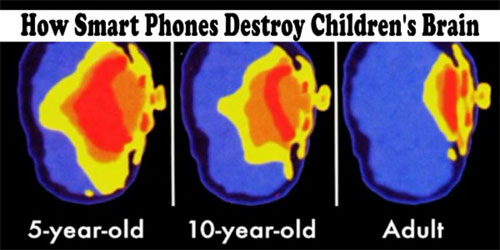Screen Dependency Disorder: The Effects of ‘Screen Time’ Addiction

The next time you leave your house and venture off into a public place, take a minute to look around. If we’re living on the same planet, it won’t be long before you see a child with eyes glued to a screen almost as big as his or her face.
While we have witnessed some incredible technological advancements in the 21st century, parents have realized that handing a child their smartphone or tablet is a convenient solution for boredom or temper tantrums.
However, this thing called “screen time” is creating brand new mental health and behavioral problems in young kids. Some of them cry, some of them break things, and some even threaten suicide.
Screen Dependency Disorder: Excessive Screen Time Explained
Whether kids are playing video games or using smartphone apps, there is a growing mountain of evidence suggesting that young boys and girls are exhibiting addictive behavior. Why? Largely because of extensive exposure to (unregulated) screen time.
Whereas adult brains are more developed, children’s brains are susceptible to significant changes in structure and connectivity which can stunt neural development and lead to a screen dependency disorder.
Other classifications of screen dependency disorder are:
– Internet addiction disorders;
– Internet gaming disorder;
– Problematic internet use;
– Compulsive internet use;
– Pathological video game use;
– Video game addiction;
– Pathological technology use;
– Online game addiction;
– Mobile phone dependence;
– Social network site addiction;
– Facebook addiction.
In psychologist Dr. Aric Sigman’s research paper published in the Journal of the International Child Neurology Association, he writes: “‘Addiction’ is a term increasingly used to describe the growing number of children engaging in a variety of different screen activities in a dependent, problematic manner.”
8 Major Symptoms of a Screen Dependency Disorder

If you have a child or grandchild, the following symptoms may present themselves if their screen time – especially on the internet and video games – compromises their ability to function:
– Preoccupation;
– Withdrawal symptoms;
– Increasing tolerance;
– Failure to reduce or stop screen activities;
– Loss of outside interests;
– Continuation despite negative consequences;
– Lying about extent of use;
– Use to escape adverse moods.
How Prevalent Is Screen Dependency Disorder Among Kids?
One 2015 study published in Behavioral Sciences (Basel) found that 12 percent of young American adolescent gamers to be “pathological video-gamers”.
Although playing video games does not require any chemical substances or intoxication, researchers suggest that it could lead to addiction-like symptoms including the ones listed above.
For Seattle-based psychotherapist Dr. George Lynn, 80 percent of his patients’ issues stem from too much gaming, watching too many online videos, or excessively using social media. As a result, Dr. Lynn is witnessing “a personality syndrome that comes from basically unbridled, uncontrolled use of recreational use of screen media during the day and at night.”
“Most doctors, family doctors, even psychiatric practitioners are not hip to the obvious fact that a kid might be only getting two to three hours of sleep at night if that”, says Dr. Lynn. “And that causes personality problems.”
What Too Much Screen Time Is Really Doing to Our Kids
Becoming someone with a screen dependency disorder can have devastating effects. According to Family Life and Child Development specialist and Early Childhood Education consultant Claudette Avelino-Tandoc, a child’s screen dependency disorder may lead to insomnia, back pain, weight gain or loss, vision problems, headaches, anxiety, dishonesty, feelings of guilty, and loneliness.
Ultimately, however, the long-term effects of these symptoms can be as severe as brain damage. In fact, multiple studies exploring the effects of screen dependency disorder have proven that children’s brains shrink or lose tissue in the frontal lobe, striatum, and insula; these areas help to govern planning and organization, suppression of socially unacceptable impulses, and our capacity to develop compassion and empathy, respectively.

“Devices or gadgets are not bad per se. They are useful and essential tools for communication, research, learning, entertainment, among other things” says Dr. Avelino-Tandoc. “Parents are dealing with 21st century learners, what we call ‘digital natives.’ They should allow their kids to manipulate these tools. However, balance is the key word.”
5 Tips for Parents with Children Who Have a Screen Dependency Disorder
According to the American Academy of Pediatrics’ new recommendations for children’s media use and Dr. Lynn’s methods:
1. For children younger than 18 months, avoid use of screen media other than video-chatting with parents or grandparents. Parents of children 18 to 24 months of age who want to introduce digital media should choose high-quality programming and watch it with their children to help them understand what they’re seeing.
2. For children ages 2 to 5 years, limit screen use to 1 hour per day of high-quality programs. Parents should co-view media with children to help them understand what they are seeing and apply it to the world around them.
3. For children ages 6 and older, place consistent limits on the time spent using media, and the types of media, and make sure media does not take the place of adequate sleep, physical activity and other behaviors essential to health.
4. Set ground rules early and enforce them by designating media-free times together, such as dinner or driving, as well as media-free locations at home, such as bedrooms.
5. Stay in the conversation by having ongoing communication about online citizenship and safety, including treating others with respect online and offline.
yogaesoteric
June 13, 2018
Also available in:
 Română
Română
